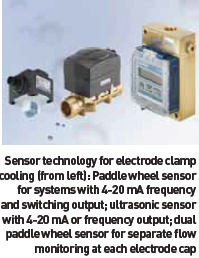
To meet the stringent quality requirements for welding while ensuring 100% availability, optimised cooling of the welding head is imperative. To continue welding, operators must quickly detect any leaks in the cooling system caused by worn electrode caps.
Carmakers often have several hundred spot welding robots in a single weld shop, with individual units sometimes producing as many as 40 high-precision spot welds within extremely short cycle times - over three shifts. In order to dissipate the heat produced by the high currents used in the welding process, it is necessary to cool the tips of the electrode clamps, commonly known as electrode caps. Copper electrodes are designed as ‘wear parts’ and must be regularly replaced. Without cooling, the electrode tips would quickly wear out, resulting in higher costs and loss of production time. To prevent this, the electrode caps are cooled with six to eight litres of water per minute, measuring between 20 and 40°C and supplied at up to10 bar. Despite continuous cooling, the electrode caps remain highly susceptible to wear and cooling water leakage. For this, manufacturers have chosen a variety of solutions.
Conventional large-size system
Electrode caps must be replaced when leakage occurs or the cap is worn out. Operators replace caps at the beginning and end of each shift as a routine measure. Cooling systems for electrode caps typically consist of components from various manufacturers. In such systems, a flow controller, feed and return valves and possibly some pneumatic control valves are connected by tubing.
One of the main disadvantages of this type of system is its size; dimensions of 1,000 x 600mm are commonplace. In plants where several robots are operating in close proximity, the space requirements for such systems can pose problems. Another disadvantage of these systems lies in the sensory equipment. The flow controllers that are normally used here are inexpensive, but their switching point is not very accurate. This significantly limits the flexibility of the system. Due to the large hysteresis of the flow controllers, response to a leak event can be slow. In addition, these controllers are unable to respond adequately to small flow rate deviations of less than one litre per minute or to small leaks. In the case of a hairline crack in the feed or return line, these units often fail to switch altogether or switch too slowly to close the cooling water circuit within the necessary time limit.
Compact, integrated tailor-made solutions The combination of sensory equipment, valve technology and controllers in small compact units provides a flexible and reliable solution for these problems. Such high-performance integrated systems can be assembled according to operator requirements from predesigned modules. This approach allows for the production of tailor-made ‘intelligent’ systems for the cooling of electrode caps that can guarantee zero leakage in the event of a loss of an electrode cap or during replacement.
The combination of sensory equipment, valve technology and controllers in small compact units provides a flexible and reliable solution for these problems. Such high-performance integrated systems can be assembled according to operator requirements from predesigned modules. This approach allows for the production of tailor-made ‘intelligent’ systems for the cooling of electrode caps that can guarantee zero leakage in the event of a loss of an electrode cap or during replacement.
Depending on the type of electrode clamps used, these modular cooling systems can be equipped with pneumatic or hydraulic drives. Operators of electrode clamps with servo motor drives are often looking for electrically-controlled. cooling and monitoring systems. Electrically-driven electrode clamps are mainly used in applications where extremely accurate positioning is required. In practice, pneumatically operated electrode clamps are still the more popular and reliable solution, as such clamps can easily be positioned with the accuracy typically required for spot welding applications.
Cooling systems with pneumatic drive elements
The integrated cooling water monitoring block consists of a pilot valve, a feed and return valve and a flow rate sensor. The main advantages of the block solution are its compact size and the option to provide additional connections for secondary cooling processes, such as a thyristor cooling system.
During operation, the pilot valve is switched so that both the feed and return valves are opened, allowing the cooling water to flow freely through the electrode clamps. As soon as a leak occurs, the flow rate sensor actuates the pilot valve. As a consequence, the feed valve is switched to close the cooling water circuit. The return valve closes with a delay that is preset by means of a restrictor. This delayed shut-off ensures that the pressure in the electrode clamps is reduced through the return valve, with backpressure of up to 2 bar reducing any leakage.
No leakage with relief cylinder
To further reduce leakage, the modular cooling system can be equipped with a relief cylinder in the form of a MasterJet unit from Bürkert. This cylinder is pneumatically preloaded during operation and relieved in the event of a leak or during cap replacement. The pressure inside the electrode clamps (maximum 2 bar) is thus relieved through the cylinder, ensuring that no water can escape while the caps are being replaced, irrespective of the actual pressure in the electrode clamps.
Cooling systems with electric drive elements
The design and function of the integrated cooling blocks, with electrically-operated solenoid valves, correspond to the pneumatically-operated systems. They also provide additional connection ports for the cooling of thyristors. The use of electrically-operated cooling systems is recommended for plants where the electrode clamps are equipped with electric servo motors, as the cooling blocks do not require compressed air supply lines. Electrically-operated cooling systems can be fitted with an auxiliary pump. In the event of a leak or during replacement of the electrode caps, the pump moves the trapped coolant to the return line, preventing any leaks. There are, however, some disadvantages to this solution, including the relatively high cost of the pump and air being trapped in the line when the machine is restarted, which can cause faulty measurements of the sensory devices.
Customised sensory equipment and valve tech
The optimum choice of sensor and valve technology for the cooling systems of spot welding robots is determined by a  number of different factors. One of the most important issues is the quality of the cooling water. It is often contaminated, containing iron and oxygen magnetite. In this case, it is recommended that direct-acting valves are used, such as seat valves or diaphragm valves, rather than electrically-driven valves, as particles in the cooling water can block the pilot channel that is crucial for the proper functioning of the latter. Diaphragm valves also offer the advantage of very low flow rate and pressure losses. If the required flow rate can only be achieved with servo-assisted solenoid valves, media-separated valves are recommended where the cooling water containing magnetite is not in direct contact with the magnetic coil.
number of different factors. One of the most important issues is the quality of the cooling water. It is often contaminated, containing iron and oxygen magnetite. In this case, it is recommended that direct-acting valves are used, such as seat valves or diaphragm valves, rather than electrically-driven valves, as particles in the cooling water can block the pilot channel that is crucial for the proper functioning of the latter. Diaphragm valves also offer the advantage of very low flow rate and pressure losses. If the required flow rate can only be achieved with servo-assisted solenoid valves, media-separated valves are recommended where the cooling water containing magnetite is not in direct contact with the magnetic coil.
Summary
Modular systems can be individually configured to provide optimised cooling solutions for specific applications and operator requirements. In contrast to conventional solutions consisting of products from various manufacturers, integrated solutions are more compact and their components are selected for optimised interoperability.
Integrated systems are suitable for various water quality levels, are available with a wide range of diameters and sensor types and come with or without display. By using a configurable control system with operator-specific software, customers can acquire intelligent cooling systems that guarantee zero leakage in the event of loss or replacement of electrode caps in their production environment.






































